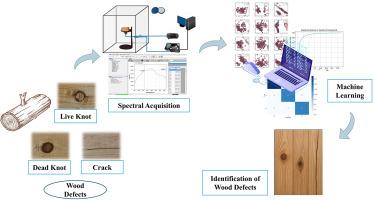机器学习模型在近红外光谱木材表面缺陷分类中的应用
IF 4.9
2区 化学
Q1 CHEMISTRY, ANALYTICAL
引用次数: 0
摘要
木材表面缺陷的准确识别对于提高木制品的质量和利用率至关重要。为了解决传统人工检测方法的低效率和准确性问题,本研究收集了Brich和Fir表面的近红外光谱(NIRS)数据,包括无缺陷样品和三种典型缺陷类型。系统地研究了机器学习模型在木材表面缺陷分类中的有效性。选择主成分分析(PCA)和递归特征消除(RFE)两种特征降维方法进行比较,筛选出具有代表性的特征变量。采用偏最小二乘判别分析(PLS-DA)、随机森林(RF)、支持向量机(SVM)和全连接神经网络(FCNN)四种分类模型对木材缺陷样本进行建模和分类。结果表明,PCA在提高模型分类性能方面优于RFE。其中,FCNN的分类准确率最高,达到98.85%,召回率和f1得分均达到0.989。这些发现证明了深度学习方法在木材缺陷识别任务中的优越性。本研究系统评估了基于近红外光谱的木材表面缺陷分类机器学习模型,为未来的研究提供了有价值的模型选择和优化见解。本文章由计算机程序翻译,如有差异,请以英文原文为准。

Application of Machine Learning Models for Classifying Wood Surface Defects Using Near-Infrared Spectroscopy
Accurate identification of wood surface defects is crucial for improving the quality and utilization of wood products. To address the low efficiency and accuracy of traditional manual inspection methods, this study collected near-infrared spectroscopy (NIRS) data from Brich and Fir surfaces, including defect-free samples and three typical defect types. The effectiveness of machine learning models in classifying wood surface defects was systematically investigated. Two feature dimensionality reduction methods, principal component analysis (PCA) and recursive feature elimination (RFE), were selected for comparison to screen out representative feature variables. Four classification models, namely, partial least squares discriminant analysis (PLS-DA), random forest (RF), support vector machine (SVM) and fully connected neural network (FCNN), were used to model and classify the wood defect samples. The results indicate that PCA outperforms RFE in enhancing model classification performance. Among the models, the FCNN achieved the best performance, with a highest classification accuracy of 98.85 %, and both recall and F1-score reaching 0.989. These findings demonstrate the superiority of deep learning methods in wood defect recognition tasks. This study systematically evaluated machine learning models based on near-infrared spectroscopy for the classification of wood surface defects, providing valuable insights for model selection and optimization in future research.
求助全文
通过发布文献求助,成功后即可免费获取论文全文。
去求助
来源期刊

Microchemical Journal
化学-分析化学
CiteScore
8.70
自引率
8.30%
发文量
1131
审稿时长
1.9 months
期刊介绍:
The Microchemical Journal is a peer reviewed journal devoted to all aspects and phases of analytical chemistry and chemical analysis. The Microchemical Journal publishes articles which are at the forefront of modern analytical chemistry and cover innovations in the techniques to the finest possible limits. This includes fundamental aspects, instrumentation, new developments, innovative and novel methods and applications including environmental and clinical field.
Traditional classical analytical methods such as spectrophotometry and titrimetry as well as established instrumentation methods such as flame and graphite furnace atomic absorption spectrometry, gas chromatography, and modified glassy or carbon electrode electrochemical methods will be considered, provided they show significant improvements and novelty compared to the established methods.
 求助内容:
求助内容: 应助结果提醒方式:
应助结果提醒方式:


